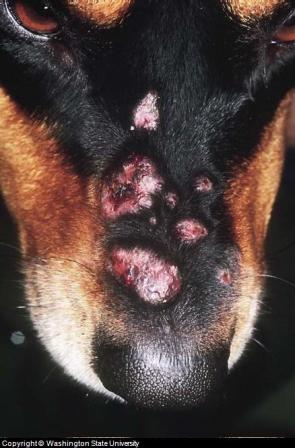Veternarians report that skin infections in dogs is the second most common type of canine skin disease after flea allergy dermatitis. A veterinarian examining any dog skin infection classifies the problem based on the severity of the condition. Mild canine bacterial infections are referred to as surface pyoderma, followed by superficial and deep pyoderma in dogs.
Pus doesn’t have to be present for a condition to be termed pyoderma, although most cases are characterized by the presence of pus filled pustules (small pus filled dog skin pimples) or papules (hard dog skin pimples). In cases where there is no obvious cause of infection such as skin injury, a vet will suspect other factors which depressed the immune system, weakening the skin’s natural infection fighting barrier.

Contents
Overview of Skin Infections in Dogs
Surface skin infections are located at the mouth of each hair follicle or in between follicles. When canine pyoderma forms in the skin folds, it is called acute moist dermatitis. As the infection penetrates the skin, pustules start to form and become more pronounced. Puppy pyoderma or impetigo develops on adolescents whose immune systems are not yet fully developed. When pyoderma is diagnosed at the hair follicle and between follicles, the condition is called superficial canine pyoderma. The most advanced cases, where infection has reached deep into the dermis is called deep pyoderma. In addition to papules and pustules, there may also be dog skin boils and granulomas (nodules that are the result of foreign bodies in the skin which interrupt healing such as a blade of grass or wood splinter).
Surface Canine Pyoderma
True to the name, infection that is simply on the surface of the skin or epidermis is called “surface pyoderma.” Associated symptoms such as itch make the problem worse, by causing the dog to scratch and further injure the skin, allowing the infection to proliferate. Dog skin problems such as flea allergy causes dog skin scratching which then introduces harmful bacteria into the skin.
Surface canine pyoderma treatment involves keeping the wound areas clean. Shampoo therapy with a benzoyl peroxide based product such as DermaBencan be of some value. For more advanced cases, a veterinarian will recommend a topical antibiotic or oral antibiotics. Breeds with skin folds are particularly predisposed to a condition named skin fold pyoderma since these areas are moist, and the skin barrier is disturbed by constant rubbing.
Superficial Canine Pyoderma
Superficial pyoderma in dogs results in dogs where the immune system is not at full strength. This is the case with puppy pyoderma, which will heal on its own as the dog matures. In superficial pyoderma there is a noticeable presence of pustules. Folliculitis in dogs is another condition where the bacteria penetrates the mouth of the hair follicles. Dog skin itch (pruritis) is more pronounced, causing more skin distress. Superficial dog pyoderma of the lips is called Mucocutaneous pyoderma and is characterized by pustules and crusting. There may be some blood that has escaped from any papules or pustules.
Deep Pyoderma in Dogs
When bacterial infection moves deep into the skin, deep pyoderma is diagnosed. Here, there are many pustules (pus filled dog skin bumps) and pustules (pus filled dog skin pimples). Lab tests can confirm if one or more infectious agents are causing the problem. The dog skin condition can be localized to one area of the body such as the muzzle, nose, or in between the dogs toes. Canine pyoderma located all over the body indicates an underlying condition such as autoimmune disease, or an endocrine disease (Cushings, hypothyroidism), among others. This condition is seen more often in Dobermans and English bulldogs.

Treatment of Skin Infections in Dogs
In general, treatment involves the use of topical antibiotics, oral antibiotics and shampoo therapy. For more advanced cases, a veterinarian may refer to a veterinary dermatologist. Once healing has began, a homeopathic such as Skin and Coat Tonic, may help to speed healing and restore the body’s natural ability to fight infection.
In cases where the condition does not heal, a veterinarian should first test for mycobacterial infection, a type of infection that is not detected in standard tests for dog skin infections. Other reasons can include selection of an incorrect antibiotic, or a dosage that is too low.
Related Articles
Dog Skin Infections
Dry Dog Skin
Dog Health
From Skin Infections in Dogs to More Information on Dog Skin


